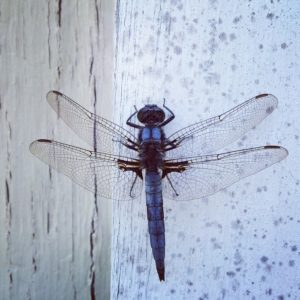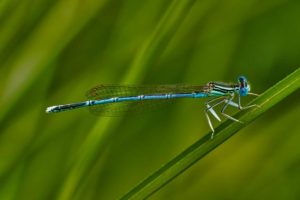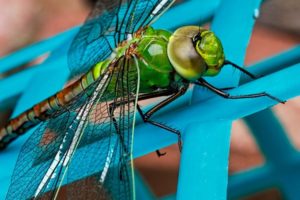There are approximately 2,875 discovered species of dragonflies in the world – about 315 in North America.

Dragonflies are between one to five inches and come in many colors.
They are not poisonous or venomous. They cannot sting you and they are not aggressive.
If in rare circumstances, a dragonfly gets close to your skin and bites you, all you’ll feel is a tiny pinch with no lasting effects.
Fun Dragonfly Facts
Dragonflies are one of the fastest insects – flying up to 40 mph.

- They can fly in any direction including backwards. Dragonflies fly left, right, up and down. They sometimes even fly upside down, but only when they need to catch an agile prey.
- They can also hover in the air. It’s no wonder they are known as the helicopters of the insect world.
- A dragonfly’s four wings contain many veins. Its heart pumps blood into its wings through theses veins for faster and more efficient flying.
- The main diet of a dragonfly is gnats and mosquitoes – thank you very much!
- The naiads (baby dragonflies) look almost nothing like the adult. In fact, naiads are aquatic! They are born submerged in water and eat other small aquatic bugs.
- In some species of dragonflies, the female will play dead when pursued by a stalking male. Clearly, she wants nothing to do with him. When the male dragonfly is duped into thinking she’s dead, he will leave. The female will make her escape.
Dragonflies in Ancient Times
Dragonflies were flying around long before the dinosaurs.
Approximately three hundred million years ago, dragonflies were much larger than they are now. From wing tip to wing tip, they measured about 28 inches. That’s bigger than the wingspan of a red-tailed hawk! Can you imagine encountering a dragonfly of that size?
What’s the Difference Between Dragonflies and Damselflies?
Damselflies are often mistaken for female dragonflies. Although they do belong to the same order of insects – Odonata – dragonflies and damselflies belong to separate suborders.


Let’s explore the differences between these two insects:
- Damselflies are slim and dainty. Dragonflies have a broader build and are usually bigger than damselflies.
- The two pair of wings of a dragonfly are different sizes. The back pair are broader at the base. Damselflies wings are about the same size.
- When a dragonfly lands, its wings extend side to side. When a damselfly lands, its wings are held together above its body.
- A dragonfly’s eyes cover most of its head and usually touch in the middle. This gives them a 360-degree view. How cool is that? A damselfly’s eyes do not touch but rather bulge out on each side of its head.
- As nymphs (babies) both the dragonfly and damselfly will dwell underwater. The damselfly nymph has 3 tail-like gills at the end of the abdomen. The dragonfly nymph’s gills are internal.
Dragonflies are both beautiful and fascinating to observe. So it isn’t surprising that “Dragonfly Watching” is a rapidly-growing hobby.
Check out other “Fun Facts” on our blog.
Related: Other Beneficial Bugs
Free Pest Inspection
